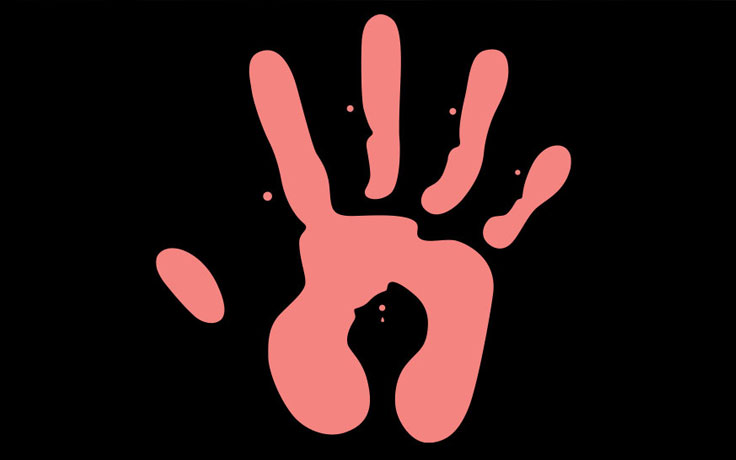UPSTAIRS, ON THE FIFTH FLOOR of the nondescript 12-story office building in the heart of downtown Los Angeles, the quiet of a July afternoon was overwhelming. Its significance was harder to pinpoint.
Here at the Los Angeles County Child Protection Hotline, hundreds of calls would normally be pouring into the phone lines, answered by scores of social workers in the cubicles lining the floor as far as the eye can see. But by midafternoon on this day, only a smattering of hushed voices could be heard. The dimly lit room was largely deserted.
This room is the alarm bell for much tragedy. It is where concerned neighbors and attentive teachers, mindful police, shopkeepers or school counselors call to report worrisome indicators of violence against children. It is where the warnings of family stress — of parents who are at their wit’s end or relatives whose rages turn on young boys and girls — reach expert ears. It is where society jumps in to aid children who cannot help themselves.
At first blush, then, it would seem that quiet here would be healthy: Fewer reports of child abuse or neglect might mean fewer children being hurt. And that’s precisely what seemed to happen in the months after COVID-19 swept this region along with the rest of the world: Calls had dropped by more than 50%. Was that a reason for hope, a suggestion that the threat of infection had dulled some of humanity’s violent desperation? Or was it something else?
“Based on my experience, I would be surprised if the incidents had gone down,” said Bobby Cagle, director of Los Angeles County’s Department of Family and Children Services since late 2017. “There’s so many additional stressors on the family these days, based on all the things that are going on with COVID, including people losing jobs, people losing income, children and families being home … I would be really surprised if the incidents had gone down.”
The calls did, however. According to Cagle, the hotline is busiest after children have been in school for about a month, then it levels off until just before winter vacation, then rises again a month after kids return from break, and it finally peaks right before summer. The pandemic stay-at-home order coincided with one of those peak periods, so calls should have been going up, not down.
“It would not be uncommon in a 24-hour period for the hotline to have something in the order of 900 calls, whereas now on a weekday, we might have only 300 calls,” said Greg Stock, the assistant regional administrator for DCFS who oversees the hotline. The massive drop in call volume, he said, was “ just stunning.”
Los Angeles has the nation’s largest child welfare system, and it, like everything else, was battered by the virus. Given the wrenching changes in everyday life, which included a sharp drop in many crimes, perhaps families had responded by bonding more closely and protectively.
Sadly, however, another possibility emerged. The stay-at-home orders that came as a result of the pandemic meant fewer opportunities for professionals or others outside the home — teachers, social workers, police — to observe children in person, making it significantly harder to identify and stop cases of abuse and neglect, as well as provide services to the tens of thousands of children and families DCFS serves through intervention and assistance programs.
Last year, the hotline received more than 207,000 calls. Of that number, nearly one-third came from teachers and school officials (about 80,000 of those calls result in an investigation, and about 6% warrant an emergency response). Educators are “mandatory reporters,” professionals who are required by law to report child maltreatment. Other mandatory reporters include law enforcement officers, childcare workers, counselors, coaches, physicians, nurses and other healthcare providers. Fewer calls, in other words, may not have meant less abuse, just less witnessing of abuse.
“The thought is that this drop in the number of calls is really due to the fact that children are not going out of their homes,” said Laura Alongi Brinderson, a field faculty member in the Luskin Department of Social Welfare who leads the California Social Work Education Center training program at UCLA. “There are not as many people putting their eyes on these children as there used to be.”
A shortage of people and supplies
FROM THE START OF THE PANDEMIC, most of the DCFS workforce remained on the job as essential workers. While some staff members could work from home, nearly all of the more than 150 hotline social workers and supervisors initially continued to report to the downtown office, which operates 24 hours a day, seven days a week. Emergency response social workers — those sent out to investigate and assess whether intervention is needed — remained at work in the field, going to family homes to check on the welfare of children.
Like many essential workers across the country, DCFS faced a shortage of personal protective equipment, or PPE, particularly the N95 masks that pro- vide the most protection from airborne particles. At the outset, Cagle says, the department had only 4,000 N95 masks for the staff of 9,000 and had difficulty securing PPE. They’ve since been able to obtain the less-protective surgical masks and other protective wear.
“We have 36,000 cases going on right now, and at any given time we have 36,000. So that means we have to have 36,000 masks for our workers on a monthly basis,” he said. “We have about a two-month supply on hand across all of our offices, but any kind of hitch in the system of production can result in our having a shortage of those items.”
The federal government and the state of California, acknowledging the lack of PPE, initially gave child welfare agencies leeway in conducting some virtual visits for non-emergency cases. The department had already begun working with the L.A. County Office of Education to explore ways to better assess children in a virtual environment, but COVID-19 accelerated those efforts.
“Like many things in the pandemic, the virtual visits are new to us,” Cagle said. “We have always felt in-person visits were the best way to go. We still believe that. But we’ve also learned that — especially in a county the size of this, with the kind of traffic issues that we have — we have been able to extend our abilities.”
One benefit of virtual visits has been the increase in caseworker contact with children. On average, Cagle says, they now have three to four contacts per child compared with one or two visits in person. “There may be things we can do to try to make a better system based upon what we’ve learned,” he said.
“The other side of the door”
FOR EMERGENCY RESPONSE WORKER Tania Cendejas, COVID-19 is making an already tough job more challenging.
“Even on a perfect day, you don’t really know what’s on the other side of the door or what kind of family you’re going to encounter,” said Cendejas, who started with DCFS in 2015 and has been an emergency response worker since 2018. “In general, families and parents are doing the best they can do, given the circumstances. But there’s been a whole other layer when you think about families that have been affected by job loss or actually contracting COVID. It’s just a whole other layer of hardship.”
Much of her routine remains the same, with the added precautions of PPE and social distancing. After receiving hotline referrals, gathering background information — school and medical records, law enforcement reports and other documentation — she heads out to family homes, where she will show up unannounced. Some assignments, such as visits to the Women’s Central Jail to see clients, have required additional measures.
“I wore safety goggles and was super mindful of throwing away my pen after I signed in and changing out of my clothes right away when I got home,” she said. Other assignments involve pass- ing on information to families about resources they may need, such as food or housing.
Cendejas, 33, knows firsthand how this process can impact someone’s life. When she was 2, she entered the system and was ultimately adopted in 1993. Today, she is assigned to the regional office in Lakewood where her own adoption worker once was based. The pandemic in the spring and the Black Lives Matter protests during the summer have added to the mental and physical challenges of her job, but she remains determined.
“I always have to keep in the back of my head that ultimately this is a point of intervention that could, potentially, ensure that the child is safe,” she said. “Or if the family requires further intervention with the department, this is the outlet, and this could transform the trajectory of a child’s or a family’s life, depending on my assessment.”
CALIFORNIA LAW REQUIRES that social workers respond within 10 days to non-emergency calls received by the hotline. In Los Angeles County, the response time has long been five days, but because of the challenges surrounding COVID-19, DCFS has moved back to the state-mandated 10 days.
Upon any initial contact, emergency social workers try to separate the child from his or her parents — especially when there is evidence that a child is being maltreated — to ensure the child can speak freely. Often, those first meetings take place in a school setting, where social workers are permitted to interview children for 30 to 45 minutes without parental consent. The school closings due to the pandemic eliminated that option. With the children now at home, the social workers still try to separate from the parents, talking with the children outside in the yard or elsewhere. Those conversations are far more difficult, however, than in the more neutral area of a school.
At the outset of the stay-at-home order, the court suspended in-person visits for children already in the system and their families, instead calling for remote visitation when possible. It later revised that order, but visits remained a challenge since the DCFS offices, public libraries and many restaurants — common meeting places for the families — were closed. In addition, case plans for families in the system initially came to a standstill as the courts limited hearings to emergency cases, such as detention hearings for newly detained children. Later, the courts conducted “stipulated hearings” for cases in process of reunifying families or cases that could be closed for which all parties were in agreement.
THE OUTLAY FOR THE ADDITIONAL PPE put an unexpected dent into DCFS’ $2.6-billion budget. More significantly, the pandemic shutdown led to an enormous decline in sales tax revenue that the state allocates to DCFS and other agencies. “As the economy has taken a downturn, we’ve taken about a $200-million hit to our budget in very short order,” Cagle said. “We’re really having to tighten our belt in very specific areas — including staffing — to be able to meet those cuts.”
Fighting COVID and misinformation
Amid all of the challenges posed by COVID-19, DCFS also found it had to combat misinformation, such as false rumors that children would be removed from a household if a parent was found to have COVID-19. Those suspicions spring from long-standing apprehension about the agency, which has weathered high-profile deaths of children in its care.
“Most child agencies struggle with the perception that we are baby snatchers,” Cagle said, “that our existence is around taking children out of homes, when in fact, if a child welfare system is operating correctly, it is about preserving families and making sure we don’t take children out of the home.”
Brinderson, whose CalSWEC trains master’s degree students to work as child welfare or child protective service workers, says the last resort should be separating children from their parents. “The goal should always be the least disruptive intervention possible,” she said. “It has to be pretty evident that the parent is a risk to a child for removal to happen, because that’s going to be the last resort.”
At the end of April, DCFS created a public service announcement to raise awareness about the drop in reports and to enlist the community’s help to ensure children and families are “safe at home.”
Families are facing a great amount of stress right now — and greater stress than at almost any moment in recent history. “That, in and of itself, concerns me,” Cagle said. “But that concern needs to translate for us into providing supportive services to families and being there to support them.”

























